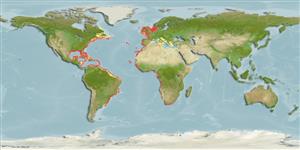Classification / Names
Common names from other countries
Main reference
Size / Weight / Age
Max length : 60.0 cm TL male/unsexed; (Ref. 7348); common length : 44.0 cm TL male/unsexed; (Ref. 47377); max. published weight: 6.2 kg (Ref. 40637)
Length at first maturity
Lm 16.3, range 13 - ? cm
Environment
Marine; reef-associated; depth range 0 - 100 m (Ref. 7348), usually 0 - 55 m (Ref. 55172)
Climate / Range
Subtropical, preferred 24°C (Ref. 107945); 58°N - 37°S, 98°W - 36°E
Distribution
Eastern Atlantic: Mediterranean to Moçamedes, Angola. Western Atlantic: Nova Scotia (Canada), Bermuda, and northern Gulf of Mexico to Argentina (Ref. 7251).
Countries | FAO areas | Ecosystems | Occurrences | Introductions
Short description
Dorsal
spines
(total): 3;
Dorsal
soft rays
(total): 26-29;
Anal
spines: 0;
Anal
soft rays: 23 - 26. Tall, with a small mouth and plate like scales (Ref. 35388). Three faint irregular broad dark bars on body; a narrow pale transverse band on chin; small light blue spots on upper half of body and median fins, and irregular short lines ventrally (Ref. 13442).
IUCN Red List Status (Ref. 115185)
Threat to humans
Reports of ciguatera poisoning (Ref. 30911)
Human uses
Fisheries: commercial; gamefish: yes; aquarium: public aquariums
Tools
Special reports
Download XML
Internet sources
Estimates of some properties based on models
Phylogenetic diversity index
PD50 = 0.5078 many relatives (e.g. carps) 0.5 - 2.0 few relatives (e.g. lungfishes)
Trophic Level
4.1 ±0.2 se; Based on diet studies.
Resilience
Medium, minimum population doubling time 1.4 - 4.4 years (K=0.18-0.43; tm=1)
Vulnerability
Moderate to high vulnerability (49 of 100)
Price category
